Meta Ads' Location Glitch? 4 Hidden Factors Behind Off-Target Reach
 Adshine.pro05/28/202564 views
Adshine.pro05/28/202564 viewsA frequent frustration among Meta advertisers is the suspicion that their ads are being shown to users outside their intended geographic targets. But is this actually happening? And if so, is it a real issue or just a misunderstanding?
In most situations, there’s a logical explanation. The root of the confusion often lies in how location targeting actually functions within Meta’s advertising system — which isn’t always as straightforward as it seems.
Let’s break this down and clarify what’s really going on — and explore what options, if any, are available to you if you’re seeing unexpected results.
1. People Living In or Recently In
This is where most of the confusion begins. Roughly two years ago, Meta introduced a significant update to how location targeting works. Previously, advertisers had four distinct options to define how their ads reached people in a geographic area.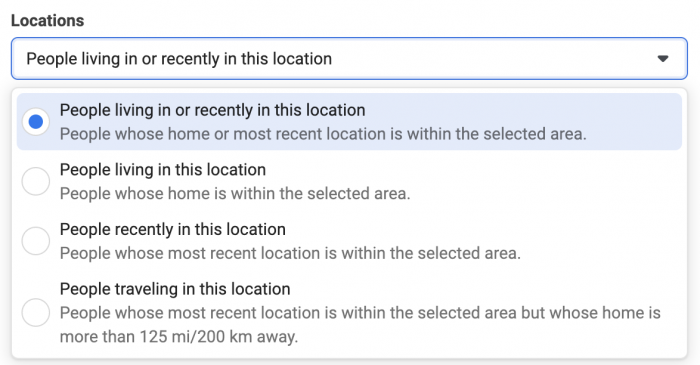
Previously, advertisers had more flexibility when targeting by location. Although “People living in or recently in” was the default, you could also choose from the following options:
- People living in this location
- People recently in this location
- People traveling in this location
In short, advertisers could tailor their reach to specific types of users based on their relationship to a location. However, after Meta's update, only one targeting option remains: “People living in or recently in” a location.
Meta appears to have removed detailed documentation explaining how location is determined, but back in 2018, Luke provided insight into how “living in” and “recently in” were defined at the time.
People who live in this location were identified by the current city listed on their Facebook profile, validated through their IP address and the listed locations of their Facebook friends.
People recently in this location were determined by their most recent physical presence in the area, based solely on mobile device data. This group could include both residents and travelers.
While we can't confirm that this exact method is still used today, it provides a useful foundation for understanding how Meta may determine location data.
It’s also worth noting that if Meta continues to rely on profile information, a user’s listed city might be years out of date. Someone could have moved long ago without updating their profile.
The key takeaway: When you target a specific location, you're not just reaching people who live there. You’re also including those who have passed through recently. That overlap often explains why ads are shown to people advertisers didn’t intend to reach.
2. Location Radius
This is especially an issue when targeting a specific city to promote a local business. Let’s assume you want to reach everyone in Denver. You would do this…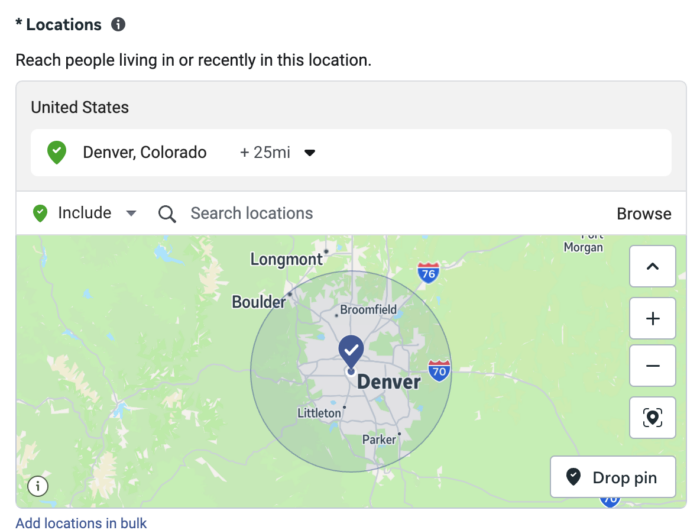
As shown in the screenshot above, Meta’s default location targeting includes a radius of +25 miles. In the case of a city like Denver, this wide radius also covers areas like Boulder — a very different city that can be more than an hour away from parts of Denver.
Even if you’re diligent enough to reduce the radius, the smallest allowed range is still +10 miles.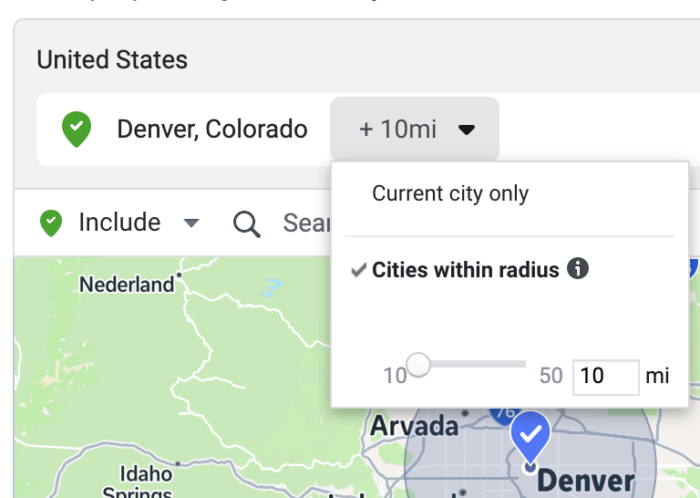
This setup will also include people in nearby cities like Thornton. And once again, it’s important to remember that these individuals may not actually live in Denver (or Boulder or Thornton) — they may have simply passed through or visited one of those cities recently.
3.Location Expansion
Meta introduced a feature last year that gives advertisers the option to expand their reach beyond their specified target area.
When you choose a particular city or region, you’ll likely notice an option labeled “Reach more people likely to respond to your ads.” This setting is often enabled by default — but you can deselect the checkbox if you prefer to keep your targeting strictly limited to the chosen location.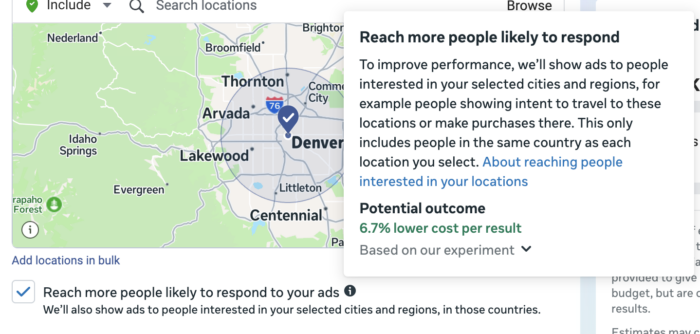
When enabled, Meta will broaden your targeting to include “people interested in your selected cities and regions.” This can mean individuals who show signs of planning to travel to those areas or who are considering making purchases there.
Keep in mind, this expansion stays within the boundaries of your selected country — so your ads won’t be shown to someone in Canada simply because they’re interested in Denver. However, it does mean that you could reach users who neither live in nor have recently visited the location you've targeted.
4. Organic Reach
This is another major source of confusion. Advertisers often analyze the comments or likes on their ads and try to determine where those users are located. But this method can be misleading for several key reasons:
- A person’s listed profile location might not match their real-time location as detected by their mobile device.
- - If you enabled the option to reach users showing interest in a location, people within the country who researched that area may still be included.
- - The ad may have reached them organically — not through paid placement.
There are many ways someone can encounter your ad organically. For example, it might appear in their feed if a friend you targeted engaged with it. Ads can also be discovered through channels like Meta’s Ad Transparency tools.
The key takeaway: Not everyone who interacts with your ad did so because of paid targeting. Some users may have been exposed to it without any ad spend on your part.
Use Breakdowns to Confirm- If you believe your ads are reaching users outside of your intended location — even though you’ve disabled the location expansion option — it’s worth taking a closer look using the Breakdown feature in Ads Manager.
Navigate to the Breakdown dropdown, scroll to the Geography section, and choose either “Country” or “Region.” This will give you a clearer view of where your ad impressions and results are actually coming from.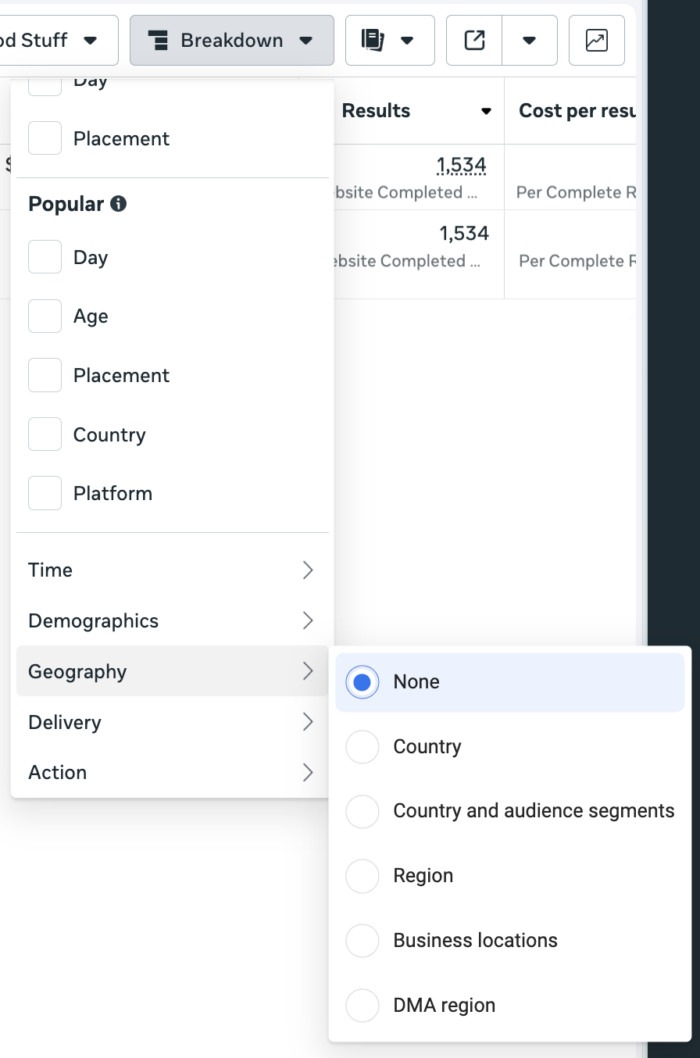
You can then see how your ad spend and results are distributed by location.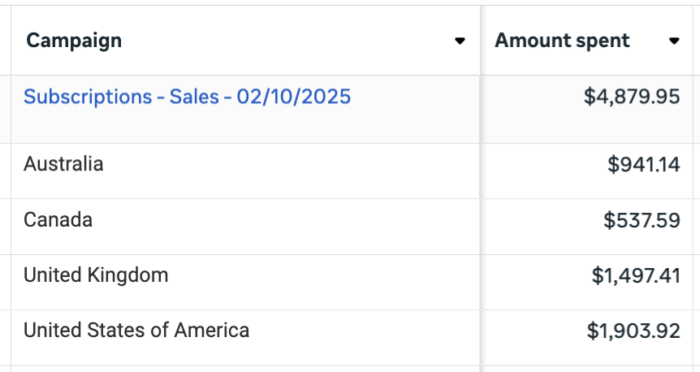
In most cases, you’re unlikely to discover anything out of the ordinary.
Other Exceptions- Of course, it is entirely possible that a very small portion of your budget will be spent on people who go beyond any of these explanations. Meta does acknowledge this.

The crucial part is this: - Because these signals can vary, complete accuracy isn’t guaranteed. Occasionally, you might notice a small number of ad impressions or even receive a message or lead from outside your specified location settings.
We wouldn’t consider this an “ah hah” moment that explains all your concerns. This simply accounts for why a few impressions from outside your targeted area show up when using the Breakdown by Geography.
However, it’s unlikely to have any significant impact.
Can It Be Controlled?
We’d love to provide a detailed explanation on how to ensure your ads reach only the intended audience. Unfortunately, advertisers currently don’t have strong control in this area.
Can you restrict your ads exclusively to people living in a location if you’re a local business? No.
Can you limit your ads solely to those traveling in a location if you’re in travel or tourism? No.
We’ve seen some advertisers suggest complex geo-fencing tactics that exclude everyone outside a certain radius.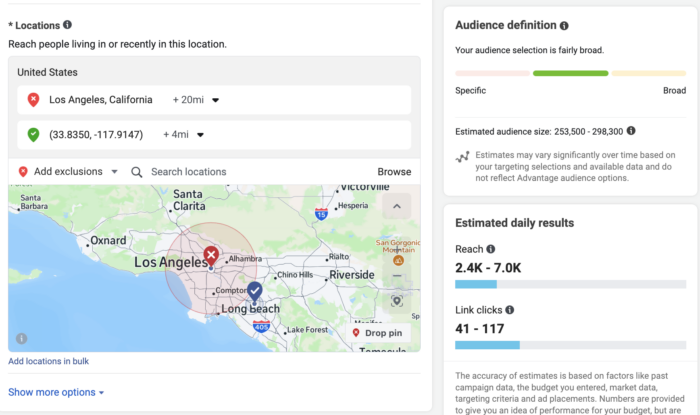
Although it might seem logical to exclude everyone living outside your targeted location, this approach can backfire because it will also filter out people who live in your target area but are temporarily traveling in the excluded zones.
It’s worth testing if you’re facing significant problems, but it’s definitely not a perfect fix.
Your main focus should be on the elements you actually control:- - Ad creatives that reference the targeted area
- - Ad copy that directly addresses people from the targeted location
- - Form fields that highlight eligibility based on location
Your ad copy, creative, and forms can help attract the right audience and discourage the wrong one. Since the algorithm learns from those who take the desired actions, you can potentially reduce location mismatches through well-crafted copy and creative.
📢 If you're interested in Facebook-related solutions, don't hesitate to connect with us!
🔹 https://linktr.ee/Adshinepro
💬 We're always ready to assist you!
